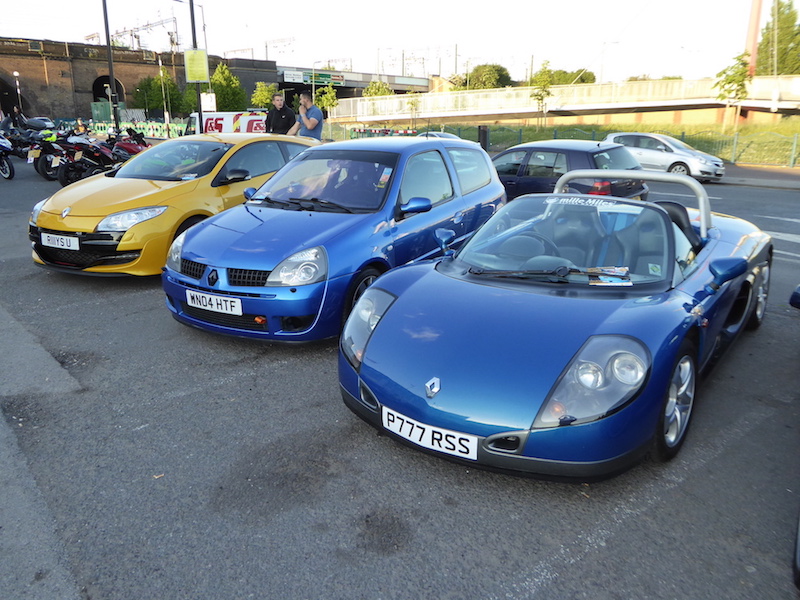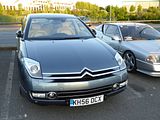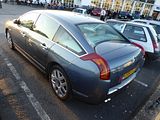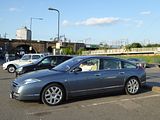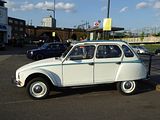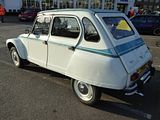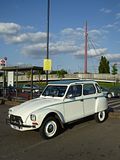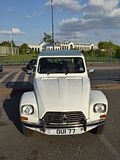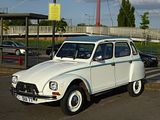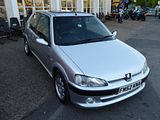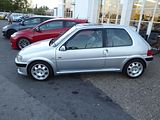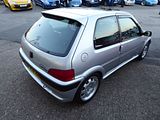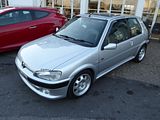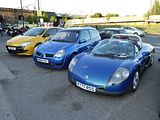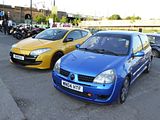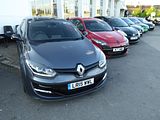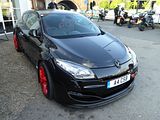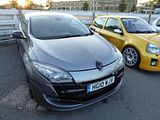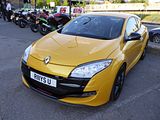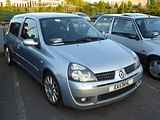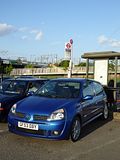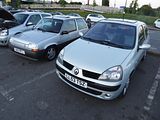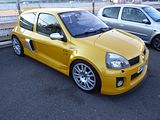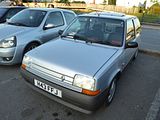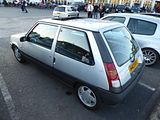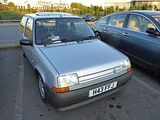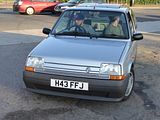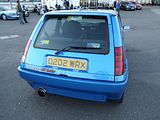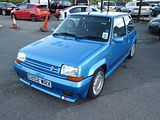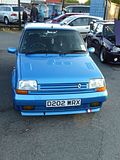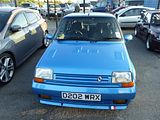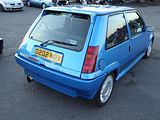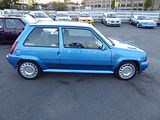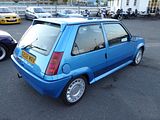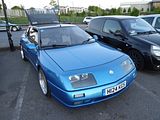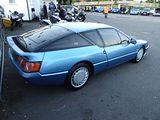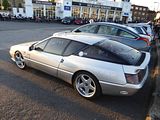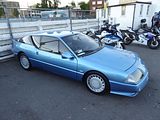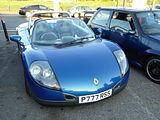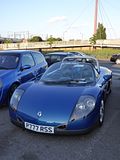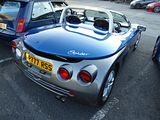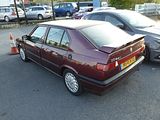CITROEN
One of my favourite French cars of recent times was one of the few parked up when I arrived. The owner was sitting in it, with his door open, for ventilation and facing the sun, a position he kept up for a considerable time. Eventually he did get out of the car and wander over, and we struck up conversation. It turned out that he was not local, but had been in London on business, and had decided to come along in the hope of seeing some classic French metal, the sort of cars that used to be common even on roads, 30 years ago. He was a bit disappointed that none such were, at the time, there, and said that unless something interesting arrived “soon”, he would go. I noticed that he did not carry out his promise until well into the evening! That did give me the opportunity to grab a few pictures of his car without the door half open. The C6 was inspired by the Citroën C6 Lignage prototype which was first shown at the Geneva Motor Show in the spring of 1999. When shown, it was clear that this was a potential replacement for the XM, and Citroën was intent on launching it before the end of 2000. It took rather longer than that, though, with the production C6 not being launched until 2005, four years later than Citroen had originally planned and five years after the XM had ceased production. In appearance, it was not very different form the C6 Lignage concept, though it did lack the rear suicide doors. Intended to compete against the might of the German executive triumvirate of E Class, 5 Series and A6, as well as be a flagship French model, the C6 was launched with the choice of a 3.0 litre V6 petrol engine producing 208hp or a 2.7 litre V6 HDi diesel producing 201 hp (shared with the Jaguar models of the time). In October 2006 a 2.2 litre 4 cylinder HDi producing 168hp joined the range and in June 2009 the V6 diesel unit was enlarged to 3 litres and now producing 237 hp. Few other changes were made to the car during its product life. Despite the looks, the C6 was a conventional saloon, with a boot lid, as opposed to a hatchback (just as the earlier CX had been). Citroën hoped that as well as its undoubted elegance, the C6’s selling points would be its innovative technology, which included a head-up display, a lane departure warning system, xenon directional headlamps (also available on the Citroën C4 and Citroën C5), and the Hydractive 3+ suspension with electronically controlled springing and damping which gave the car a “magic carpet” like ride, and a rear spoiler which automatically adjusted to speed and braking. On launch, the press used phrases such as “spaceship that rides on air”, “charmingly idiosyncratic” and “refreshingly different”. Unsurprisingly, the C6 immediately became a prominent vehicle among the fleet of executive cars of the Élysée Palace. Former Presidents of France, Jacques Chirac & Nicolas Sarkozy, have chosen the Citroën C6 as their official car. Chirac, in particular, used a pre-series car before the model was introduced. But finding buyers among the general public proved more difficult. At launch sales expectations across the model’s lifespan were given as 20,000 per year, but when production ended on 19 December 2012, only 23,384 units built over a 7 year period.
This delightful example of the Dyane arrived only a few minutes after I did, and when I saw it pull in, I suspected that this could be the start if an evening of interesting cars. The owner headed straight into the Cafe, and was not there for longer than the time it would take to get a meal cooked and eaten, before he emerged, got in the car and drove out. Sadly. It would have been interesting to find out a little more about this car, as you really don’t see the Dyane very often these days. Launched on its home market in August 1967, it was, of course, a development of the Citroën 2CV, and was intended as an answer to the increasingly popular Renault 4, which after its introduction in 1961 had affected 2CV sales. The Renault 4 incorporated many ideas copied from the Citroën Traction Avant, but on a smaller scale. Like the Renault 4, the Dyane was designed from the outset as a hatchback with some other styling differences, such as conventional round headlamps set into the front wings with a squared stainless steel trim ring – as opposed to the old-fashioned separate units found on the 2CV – and stainless steel wheel embellishments as standard. It was often asserted that the Dyane was intended to replace the 2CV, and although this had been the original idea, by the time the car was launched it was positioned to fill a small niche between the manufacturer’s 2CV and Ami models. The 2CV had been developed and, in 1948, launched at a time of austerity and low wages. More than twenty years later, with the much more modern Renault 4 selling strongly against the Citroën offerings, it was thought that buyers must be ready for a less aggressively basic approach. During the years since 1948 production technology had become more streamlined, as auto-industry wages grew ahead of the overall growth in the French economy, and production of the 2CV was, by the standard of more recent models, a very labour-intensive process. At the time of the Dyane’s development, the Citroën design department was busy on updates of the key DS and Ami models: design of the Dyane was therefore initially subcontracted to the Panhard design department, Panhard’s non-military business having in 1965 been absorbed into Citroën’s car business. The Panhard team under Louis Bioner (who had designed every Panhard model introduced between the late 1920s and the mid 1960s) produced a proposal that at a detailed level proved controversial with Citroën’s design chief, Robert Opron: the car was significantly reworked ahead of launch. The Dyane’s Panhard associations are also reflected in its name, Panhard having registered a copyright on the name Dyane along with Dyna, Dynavia and Dynamic. At launch the car was offered with two levels of equipment and trim: The Basic “Luxe” and the slightly better equipped “Confort”. The “Confort” version was differentiated from the outside through the inclusion of hub-caps on the wheels. The spare wheel and jack were mounted in a special cradle under the bonnet rather than both simply being placed loose on the floor of the luggage area at the back. The interior of the “Confort” was slightly less basic, with plastic moulded door panels rather than flat, vinyl covered hardboard. The steering wheel was less “rustic” than that which the less expensive “Luxe” version of the Dyane shared with the Citroën 2CV. The extra 615 francs in the 1967 domestic market listed price for the Dyane “Confort” represented a supplement of just over 10% when compared to the list price for the more basic “Luxe”. As with the 2CV, the engine was air-cooled, with a hemispherical combustion chamber and flat-topped pistons. and for the first five months only the 2CV’s 425cc engine was fitted. The “Dyane 6” was announced at the Brussels Motor Show in January 1968, fitted with the Ami’s 602cc M4 engine. This came with an advertised maximum output of 28 bhp, supporting a claimed top speed of 71 mph, which was a useful improvement over the 21 bhp of power and the claimed top speed of 100 km/h (62 mph) with which the Dyane had been launched. The 602cc engined Dyane did not replace the original 425cc engined car. However, two months later, in March 1968, the 425cc unit was replaced, in a car now described as the “Dyane 4”, by an improved 435cc engine providing 26 bhp. The extra power came from changes including not merely the slightly claimed cylinder dimensions, as well as an extra 2 mm of carburettor diameter and a raised compression ratio. Although there was a price to be paid in terms of higher fuel consumption, the listed top speed went up to 105 km/h (66 mph) and acceleration was measurably less anæmic. In September 1968 the M4 was replaced by an improved 602cc engine featuring higher compression pistons and forced induction from the engine fan giving slightly more power. As with the 2CV and Ami, cooling air was ducted straight to the heater, giving excellent demisting and heating. Mechanical contact-breakers were mounted at the front of the camshaft and located behind the cooling fan. The Fan was mounted on a tapered shaft and secured with a bolt at the bottom of a deep tube (the top of which engaged the starter handle). As the location of the points was not obvious to the uninformed, there were often neglected. The Coil fired both cylinders simultaneously (wasting one spark) and the spark plug wear was faster than it ought to have been; 6000 miles was not uncommon for a spark plug. Cylinder heads were held on with three studs and barrels slipped over the pistons. No cylinder-head gasket was used, and since the wings unbolted in a few minutes, it was possible to remove the cylinder heads and barrels, change the pistons or piston-rings and reassemble the top end very quickly, using only a few tools. The Dyane was based on the same platform chassis as the 2CV, sharing its advanced independent front to rear interconnected suspension. This comprised a central springing unit, running fore-and-aft in a tube on each side; each suspension arm on that side was linked to the spring, by a tie-rod and a ‘knife-edge’ pivot-pin. Early cars did not have conventional shock absorbers. The squeak you hear from most 2CVs and Dyanes as they go by over bumps is due to lack of lubrication either inside the spring tubes or to the ‘knife-edges’. The front hubs kingpins need to be greased every 600 miles. Since this is often overlooked, the king-pins can be prone to wear, although some movement is acceptable. During the Dyane’s first full year of production, supported by the interest and marketing activity generated by new-car launch, 98,769 Dyanes were produced which meant that it was indeed produced, even at this stage, in greater volumes than the 2CV with just 57,473 cars produced. In 1969 the Dyane was again produced at a higher rate, this time with 95,434 units as against 72,044 for the older car. However, the 2CV refused to die, and with 121,096 2CVs produced in 1970, the older car was back in front. The Dyane soldiered on, with French production rates remaining more than respectable, for more than another decade. However, the Dyane’s annual volumes would never again beat those of the 2CV and the car was deleted in 1980, several years before its older brother ended production. Few further changes were made, though from 1969, the Dyane 6 did gain a third side window, and a new grille was fitted from 1976. Minor trim updates were made, but the car remained resolutely utilitarian, and even the limited edition models such as the Code D’Azur of 1978 could not get away from the fact, not that enthusiastic owners really wanted anything else. 1,443,583 examples were made, but survival rates are low, and this car is far rarer than the 2CV.
PEUGEOT
It must have been at least 8pm before the first Peugeot of any description arrived, and when I left, some while later, it was still the only representative of the marque present. That car was a 106 GTi and it was absolutely immaculate, which is rare for a car of this type, as these models were generally driven hard and as they got older and cheaper, tended to appeal to the younger enthusiast, so few have survived and certainly not in this condition. The 106 was built between September 1991 to July 2003, and slotted into the range below the popular 205 as a partial replacement for the “sacred number”. Intended to be Peugeot’s entry-level offering, it was initially sold only as a three-door hatchback, with a five-door hatchback joining the range early in 1992. For the first year of production, the 1.0 and 1.1 petrol engines came with a carburettor, but these were replaced by fuel-injected engines from late 1992 as a result of EEC emissions regulations. Top of the range initially was the XSi, which had a 1.4 litre fuel injected unit. The entire range was facelifted in early 1996, with a new look that had a close family resemblance with the facelifted 306 and the 1.6 GTi model was added a new “top of the range” and sporting version. This car never quite captured the same level of enthusiasm as the 205 GTi had done, but it was well rated when new. It still looks good today.
RENAULT
Not surprisingly, the event was dominated by Renault models. Performance Renault models, to be more precise. The sporting Clio and Megane cars have thrilled a generation now, with hot versions of these otherwise rather ordinary hatches undergoing something of a transformation to make them among the best in class, and real cars for the enthusiast.
All the Megane models here were the soon to be replaced third generation. Sold since 2010, there have been a multiplicity of different versions, starting with a 250 bhp car which had a 2.0 litre twin-scroll turbo 4-cylinder F4Rt engine rated at 250 PS and 250 lb/ft of torque with a 6-speed manual gearbox, Brembo front brakes, front splitter, extended sills and wheel arches, rear diffuser with central exhaust pipe, and 18-inch alloy wheels wearing 225/40R18 tyres. Aluminium pedals, a Renault Sport steering wheel with thumb grips, analog rev counter and sport seats with extra lateral support dress up the cabin. Other features include front LED daytime running lights and bi-xenon headlights. A Cup version with a lightened chassis was offered from the start. In 2011, Renault introduced the Trophy which had 265bhp, and this engine was later made standard in the regular RS car as well. A couple of years later, a further 10 bhp was found, as Renault worked to regain their crown from SEAT for the fastest lap in a front wheel drive car at the Nurburgring, with the RS275 Trophy R car. This model had a raft of changes, starting with a little more power courtesy of the Akrapovič titanium exhaust bringing power up to 275 PS (271 bhp) while torque was unchanged at 360Nm. Öhlins dampers, 19″ Speedline Turini wheels and Michelin Pilot Cup 2 tyres replace the KYB dampers, 19″ Steev wheels and Bridgestone Potenza RE050A/Continental ContiSportContact 5P tyres used to date. The front brakes were changed to a 350mm rotor (up 10mm) while using the same calipers & rear brakes. Interior changes saw the deletion of the air conditioning, stereo and back seat while the Recaro Sportser CS seats are exchanged for Recaro fixed polycarbonate buckets trimmed with leather and alcantara. The total weight saving of all the changes amounted to a 101 kg loss, bringing kerb weight down to 1280 kg, 7.5 l/100 km and 174 g/km of CO2/km. The Mégane R.S. 275 Trophy also beat the records of several others circuits, proved by the videos Suzuka circuit with Laurent Hurgon, Fuji International Speedway with Laurent Hurgon, Tsukuba circuit with Kazuo Shimizu.
By contrast, it was the second generation Clio which dominated, with all bar one of the Clio models here being this version. It started out in 1999, when Renault presented the first officially branded RenaultSport Clio, though this was the third Clio produced by the RenaultSport division succeeding the Clio 16V and Clio Williams. This new Clio, the 172, was based on the 3 door Clio II shell however had numerous features over the standard car including wider arches, restyled bumpers, side skirts and 15 inch OZ F1 alloy wheels. Power was delivered by the F4R730 engine, a 2.0 litre 16 valve Inline 4 engine with a Variable Valve Timing (VVT) system via a dephaser on the intake camshaft pulley. The engine was a modified version of the F4R used in models such as the Laguna and Espace and was modified by mecachrome to deliver a power output of 170 hp. Power was delivered to the wheels via a JC5-089 5 speed Manual gearbox. The 172 also featured interior changes over the standard car including Half Leather, Half Alcantara seats embossed with the RenaultSport logo and the car also came standard with manually controlled Air Conditioning. A limited edition of the Phase 1 172 was produced and known as the Clio 172 Exclusive. This was limited to 172 units, all 172 of this “Exclusive” edition were green, featured BBS alloy wheels and a full leather interior as opposed to the half leather half Alcantara seats featured in the standard car. In 2001 the interior and exterior of the Clio II were face-lifted, the Clio RS followed suit shortly after. This facelift of the Clio 172 included redesigned front and rear bumpers, the front bumper falling in line with the style of the face-lifted Clio II. The rear bumper was now less rounded and featured a strip of ABS plastic effectively splitting the bumper into two. The lights, bonnet and boot lid were also matched to the face-lifted Clio II. The interior was also changed to closer match that of the face-lifted Clio II, the seats were slightly revised however still featured the same Half Leather, Half Alcantara fabrics and the embossed RenaultSport logo. One new feature that the Phase 2 172 featured was Automatic climate control as opposed to the manual air-conditioning featured in the Phase 1. The dashboard featured Silver interior trims and the steering wheel included a plastic insert featuring the RenaultSport logo. The gear lever was changed from the metal ball featured on the Phase 1 to a Leather wrapped gearlever with a silver coloured insert on the top. The Phase 2 172 also featured increased equipment including automatic Xenon Headlights and headlight washers, Rain Sensing Wipers a Six-Disc CD Changer and it also included Side Impact airbags integrated into the seats. The 15 inch OZ F1 Alloy Wheels were also replaced with a 16 inch Alloy Wheel of Renault’s own design. The facelift of the 172 also brought about a number of changes to the engine of the car also. A revised version of the F4R used, the F4R 736, this featured a revised cylinder head with the exhaust ports being approximately 30% smaller than those featured on the 172. The airbox was also redesigned to be much more square than the original airbox. A revised version of the JC5 gearbox, the JC5-129 was introduced in this version of the Clio 172, this revised JC5 featured a shorter Final Drive to counter the increased weight of the face-lifted 172. The catalytic converter, which on the PH1 172 had been dual barrel was reduced to a single barrel and featured 2 lambda sensors, one before and one after the catalytic converter. The biggest change to the PH2 172 over the PH1 was the introduction of an electric throttle. This meant the Idle Control Valve of the PH1 was no longer required leading to a minor redesign of the intake manifold. In 2002 Renault released the 172 Cup which bore the chassis code CB1N and was known by Renault as the “Sport lightweight version”. The vast majority of cars were produced in D43 Mondial Blue (Metallic) with a limited run of around 90 cars being produced in 640 Iceberg Silver (Metallic). The Cup, originally built for Gr.N homologation of the Clio 172 was differentiated from the “non cup” 172 by its lack of many of the luxuries included in the regular car. Instead of the Leather / Alcantara seats instead the same style seat was upholstered in a durable but low cost fabric, the Automatic Xenon headlights were replaced by manually controlled halogen units and the washer jets replaced with blanks. The rain sensing wipers and solar reflective coated windscreen were also omitted from the 172 Cup. However the car had features not before seen on a production version of the 172, these included light weight 16 inch Speedline Turini Alloy wheels, Matte Blue door strips, ABS plastic “Cup” front splitter and a restyled “Cup” rear spoiler. The dash strips which were silver on the regular car were painted to match the outside of the car. One of the main features of the 172 Cup was its significant weight saving boasting a kerb weight of 1021kg, making it the lightest of 172 versions produced. This was achieved by the removal of a majority of sound deadening from the car alongside thinner glass to reduce weight even further. One large difference was also the lack of air conditioning which was a standard fit component on the regular 172, this typically lead to the cup producing more power due to the engine having less ancillaries to drive. This however was reintroduced as an optional extra later in the production run of the Cup. The 0-60 time of the 172 Cup was officially marketed by Renault as being 6.5 seconds however Autocar Magazine reportedly timed the 0-60 at 6.2 seconds which if this were the case would make the 172 Cup the second fastest road going Clio produced at the time of this article, second to only the V6. Many enthusiasts regard the 172 Cup as the last “hardcore” hot hatch due to its lack of ABS Brakes, the car also featured modified suspension which gave it a wider track thanks to modified wishbones, the car also sat lower than standard and featured stiffer shocks and springs, the suspension geometry was revised to suit these components and to mean that the steering response was increased, this also lead to an increase in oversteer thanks to the lack of weight and revised geometry. Due to the lack of ABS the brake bias of the car was fixed by way of disconnecting the rear axle compensator, within the UK this often lead to the cars failing the MOT test, VOSA eventually issued an advisory to prevent this from happening. 2004 marked yet another refresh of the Clio II. The inserts of the headlights were changed from Black to Grey, new wheels styles were introduced and new colour options were added with others being dropped. The basic design of the car stayed the same with only minor changes. The Six-Disc CD changed was dropped as standard equipment however was still available as a cost option. This refresh marked the introduction of Cruise Control and Electronic Stability Program (ESP) as standard equipment. The Clio RS featured a lot more changes than the regular Clio. The engine was again revised and became the F4R 738. The difference between the F4R 738 and F4R 736 was a revised oil breather setup meaning the intake manifold found on a 172 would not fit a 182. Thanks to a number of other changed this engine produced 182 PS (180 hp) . This increase in power was thanks to the addition of a 4-2-1 Manifold and high flow 200 cell sports catalytic converter. The spare wheel well was removed and replaced with a flat floor to make way for the new dual exit exhaust featured on the 182. Minor revisions were made to the interior, the perforated texture of the Alcantara on the seats now featured white dots and the Recaro Trendline reclining bucket seat was offered for the first time as an option costing £500 in the regular 182 and £800 in the Cup version. The rarest optional extra available was the Carminat Sat-Nav which was fitted to very few cars. The unit wasn’t a popular option however due to its high cost and rumoured poor performance compared to aftermarket options. The “Cup” Front Splitter and “Cup” Spoiler originally fitted to the 172 Cup made a reappearance as a cost option known as the Cup Style Pack. This was one of two cup packs available, the other being the Cup Chassis. This Cup Chassis pack included a strengthened hub with 60mm spacing on the strut bolt holes as opposed 54mm on non cup packed cars. The Cup Chassis also featured lowered suspension with stiffer shocks and springs, a thicker front anti roll bar and an anthracite version of the standard alloy wheels. The Clio 182 could also be ordered in a lower priced “Cup Specification”, this was available in just two colours, J45 Racing Blue and D38 Inferno Orange, however came as Standard with the Cup Chassis and Cup Style Pack. The 182 Cup lacked the Automatic Xenon headlights and headlight washer jets, Climate Control (rear footwell heater vents were also removed), illuminated sun visors, Solar Reflective Windscreen and Automatic Wipers. The Leather / Alcantara seats were replaced with cloth items and the rear bench was downgraded to match. The engine cover and sill plates were removed and the steering wheel was downgraded to no longer include the RenaultSport Logo or rubber thumb grips. Carpet and headlining were downgraded to basic specification and even the documentation wallet was changed from faux leather to cloth. Sound deadening was removed from the 182 Cup , the horn was downgraded from a twin to single unit and the interior light no longer included a map reading function. Despite all of these reductions in specification the 182 Cup was still considerably heavier than the previous 172 Cup, meaning this version of the Clio II RS was considered one of the least desirable versions. The final version of the Clio 182 was known as the 182 Trophy. This version was based on the 182 Cup and featured the same strengthened hubs with 60mm bolt spacing. Originally only 500 cars were to be produced for the UK market however an additional 50 were produced to be sold in Switzerland. At the time, believing there was no market for this version of the Clio, the Marketing Department of Renault France failed to order a 182 Trophy. The 182 Trophy included 16 Inch Speedline Turini Alloy wheels as seen on the 172 Cup, the Spoiler from the Clio 255 V6, Recaro Trendline seats and exclusive 727 Capsicum Red Paint with Trophy Decals lacquered onto the Side skirts. Each car had an individually numbered plaque on the base of the driver’s seat. The biggest difference however between the 182 Cup and 182 Trophy was the inclusion of Sachs Remote-Reservoir Dampers. The basic principle of a Remote-Reservoir Damper is that because there is a separate reservoir for the Gas / Oil which fills the shock they can either be of a reduced length or can house a longer rod, this means that the sizing of the shock can be optimised for the application in which it is being used. These changes definitely made a big difference to the 182 Trophy and in fact have lead to it being heralded as one of the best hot hatches of all time.
Mid evening saw the arrival of this fabulous Phase 2 Clio V6 in the very distinctive Liquid Yellow colour which was a popular option on all RenaultSport models a few years ago. The Renault Clio V6 Renault Sport , to give the car its full and rather cumbersome name, was a rear mid-engine, rear-wheel-drive layout hot hatch based on the Renault Clio launched in 2001, very much in the same style as the earlier mid-engined R5 Turbo models of the 1980s. Designed by Renault, the Phase 1 models were built by Tom Walkinshaw Racing and Phase 2 were designed and helped by Porsche and built by Renault Sport in Dieppe. The Clio V6 was based on the Clio Mk II, though it shared very few parts with that car. The 3.0 litre 60° V6 engine, sourced from the PSA group. It was the ES9J unit as used in the Peugeot 406, 407 and 607, and the Citroen C 5 and not the one that Renault used in the 3 litre Laguna engine, which had an PRV (Peugeot, Renault & Volvo) an earlier development 90° V based on a V8 that never was. For this car it was upgraded to around 227 bhp and placed in the middle of the vehicle where the more ordinary Clios have rear seats – making this car a two-seater hot hatch. In order to accommodate the radical change from front-engine, front-wheel drive hatchback to mid-engine, rear-wheel drive two-seater quasi-coupé, the car had to be extensively reworked structurally, leading to the Phase 1 version being some 300 kg (660 lb) heavier than the sportiest “regular” Clio, the 172 Cup. Due to this, even though the V6 model had significantly more power, it was not remarkably faster in a straight line accelerating to legal road speeds than the 172 Cup – accelerating to 60 mph in 6.2 seconds compared to the Cup’s 6.7 seconds – though its maximum speed was significantly higher at 146 mph compared to 138 mph. Opinions varied on the handling, but many found it very twitchy and the car soon a gained a reputation for breaking away with little warning. That was largely addressed by the Phase 2 cars which were launched in 2003. The front end took on the same sort of new design as had been applied to the regular models. The engine was upgraded, to make the Phase 2 Clio V6 the most powerful serial produced hot hatch in the world with 255 bhp exceeding the 247 bhp of the Alfa Romeo 147 GTA and the 222 bhp SEAT León Cupra R. Based on the Phase 1 engine, its extra performance was helped with assistance from Porsche and although the Phase 2 gained even more weight, the result was a a reduced 0–60 mph run at 5.9 seconds and a top speed of 153 mph. Though based on a utilitarian hatchback, the Clio V6 was not a practical family car. With an average fuel consumption of 24 mpg, this resulted in an empty fuel tank in just over 300 miles. The loss of the back seats and most of the boot space, due to the engine placement, resulted in a severe restriction in luggage space – there was only a small space in the front where the engine used to be, suitable for a holdall or week-end groceries, a small netted area behind the seats plus a small stash area under the tailgate. The enhanced steering made tight manoeuvring a little challenging, the turning circle being a rather awkward 13 m (42.7 ft) – around three car lengths – turning what might normally be a three-point turn into a five-point turn. Standard equipment in the car was good, this was not a stripped-out special, and it included rain sensing windscreen wipers, automatic headlights, air conditioning, and six speakers and CD changer. The Phase 2 Clio V6 retailed for £27,125 in the United Kingdom, until it was withdrawn from sale in 2005 coinciding with a facelift for the Clio range. The Phase 2 was received far more enthusiastically by the ever-critical UK press. These days there is no doubting the fact that this is a a modern classic.
Predecessor to the Clio was the second generation R5, sometimes referred to as the “Supercinq”. There were two models here. One was a regular car, in the limited “Famous Five” edition. The “Supercinq” appeared in the autumn of 1984, with RHD models going on sale in February 1985. Its launch came within 18 months of Ford, General Motors, Peugeot, Fiat and Nissan all launching new competitors in the supermini sector. Although the bodyshell and chassis were completely new (the platform was based on that of the larger Renault 9 and 11), familiar 5 styling trademarks were retained; with the new styling being the work of Marcello Gandini. The new body was wider and longer featuring 20 percent more glass area and more interior space, with a lower drag coefficient (0.35), as well as 68.9 mpg at 56 mph in the economy models. The biggest change was the adoption of a transversely-mounted powertrain taken directly from the 9 and 11, plus a less sophisticated suspension design, which used MacPherson struts. When launched, it had the following ranges: TC, TL, GTL, Automatic forms. The entry-level TC had the 956 cc engine rated at 42 bhp, while the TL had the 1108 cc engine rated at 47 bhp, and the GTL, Automatic, TS and TSE had the 1397 cc engine rated at 59 hp for the GTL, 67 hp for the Automatic, and 71 hp for the TS and TSE). The TC and TL had a four-speed manual gearbox, while the GTL, TS and TSE had a five-speed manual gearbox (which was optional on the TL), and the Automatic had a three-speed automatic gearbox. 1987 saw the introduction of the 1721 cc F2N engine in the GTX, GTE (F3N) and Baccara (Monaco in some markets, notably the United Kingdom). Renault decided to use the naturally aspirated 1.7 litre from the Renault 9/11, which utilised multipoint fuel injection, in addition to the sports orientated 1.4 litre turbo. Under the name GTE, it produced 94 hp. Although not as fast as the turbo model, it featured the same interior and exterior appearance, as well as identical suspension and brakes. The Baccara and GTX versions also used the 1.7 engine – the former sporting a full leather interior, power steering, electric windows, sunroof, high specification audio equipment and as extras air-conditioning and On-Board Computer. The latter was effectively the same but the leather interior was an option and there were other detail changes. As with the previous generation, the 5 Turbo was again assembled at the Alpine plant in Dieppe, where forty cars per day were constructed in 1985. The model was starting to show its age by 1990, when it was effectively replaced by the Clio, which was a sales success across Europe. Production of the R5 was transferred to the Revoz factory in Slovenia when the Clio was launched. It remained on sale with only 1.1 and 1.4 litre petrol and 1.6 litre naturally aspirated diesel engines, as a minimally equipped budget choice called the Campus. until the car’s production run finally came to an end in 1996. A number of limited edition models were offered throughout the model’s life. These tended to be market specific. The “Famous Five” was produced for the UK in March 1990, just before the unveiling of the follow-on Clio. Based on the TR, it had the 55bhp 1.1 litre petrol engine, and was available with three or five doors. As well as the special stickers on the side of the car, still evident on this one, the model had reclining seats, a special two-tone upholstery, heating, quartz clock, sunroof, variable speed wipers, a Boombox Philips radio, side vents on the dashboard and tinted windows.
A “hot hatch” version, the GT Turbo, was introduced in 1985. It used a modified four cylinder, eight-valve Cléon 1,397 cc engine, a pushrod unit dating back to the 1962 original (in 1,108 cc form). It was turbocharged with an air-cooled Garrett T2 turbocharger. Weighing a mere 850 kg (1,874 lb), and producing 113 hp, the GT Turbo had an excellent power-to-weight ratio, permitting it to accelerate from a standstill to 60 mph in 7.5 seconds. To differentiate it from the standard 5, it came with blocky plastic side skirts. Unfortunately, turbo lag was an issue, along with poor hot starting, and it was considered rather difficult to control. The same engine was used, with similar issues, in the Renault 9 and 11 Turbos. In 1987, the facelifted Phase II was launched. Major changes in the Phase II version included installing watercooling to the turbocharger, aiding the Phase I’s oil-cooled setup, which extended the life of the turbo. It also received a new ignition system which permitted it to rev 500 rpm higher. These changes boosted engine output up to over 118 hp. Externally, the car was revamped, with changes (including new bumpers and arches) that reduced the car’s drag coefficient from 0.36 to 0.35. Giving the Phase II a 0–100 km/h time of 7.5 secs. In 1989 the GT Turbo received a new interior, and in 1990 the special edition Raider model (available only in metallic blue, with different interior and wheels) was launched. In late 1991 the Renault 5 GT Turbo was discontinued, superseded by the Clio 16v and the Clio Williams. Survival rate of the R5 GT Turbo is low and few cars are particularly original, so this was nice one to behold, even if the bright blue colour is not a factory original shade There were a number of more heavily modified versions here as well.
Last models to arrive before I departed were a couple of Renault-Alpine GTA cars. Follow on to the A310 that was never officially sold in the UK, this was the first car launched by Alpine under Renault ownership, though Alpine had been affiliated with Renault for many years, with its earlier models using many Renault parts. It was conceptually similar to the A310, updating that car’s silhouette with modern design features like body-integrated bumpers and a triangular C pillar with large rear windshield. It used the PRV V6 engine in a rear-engined layout, with extensive use of Polyester plastics and fibreglass for the body panels making it considerably lighter and quicker than rivals such as the Porsche 944. It was one of the most aerodynamic cars of its time, the naturally aspirated version achieved a world record 0.28 drag coefficient in its class. The GTA name, used to denote the entire range of this generation, stands for “Grand Tourisme Alpine” but in most markets the car was marketed as the Renault Alpine V6 GT or as the Renault Alpine V6 Turbo. In the UK, it was sold simply as the Renault GTA, as Sunbeam and then Chrysler/Talbot had been using the “Alpine” badge since the 1950s. Rather than being cast in a single piece as for the preceding A310, the new Alpine’s body was cast in a large number of small separate panels. This required a major overhaul of the Alpine plant, leaving only the sandblasting machinery intact. The car was also considerably more efficient to manufacture, with the time necessary to build a finished car dropping from 130 to 77 hours – still a long time, but acceptable for a small-scale specialty car.The PRV engine in the naturally aspirated model was identical to the version used in the Renault 25, a 2849 cc unit producing 160 hp. Also available was the smaller (2.5 litres) turbocharged model. The central backbone chassis (with outriggers for side impact protection) was built by Heuliez and then transferred to Dieppe – aside from the body, most of the car was subcontracted to various suppliers.[4] At the time of introduction, daily production was ten cars. This soon dropped considerably, as the somewhat less than prestigious Renault had a hard time in the sports car marketplace. The average production for the six full years of production was just above 1000 per annum, or just above three per day. The first model introduced was the naturally aspirated V6 GT, which entered production in November 1984, although press photos had been released in September 1984. The car was first shown at the 1985 Amsterdam Rai, immediately after which it also went on sale. In July 1985 the Europa Cup model appeared; this limited edition model was intended for a single-make racing championship and 69 cars were built (54 in 1985 and 15 more in 1987).In September 1985 the turbo model followed, which increased the power of the PRV unit to 200 PS. At the 1986 Birmingham Show the right-hand-drive version was presented and UK sales, as the Renault GTA, commenced. In early 1987 a catalysed version appeared, with fifteen less horsepower. This meant that the Turbo could finally be sold in Switzerland, and later in other European countries such as Germany and the Netherlands when they adopted stricter legislation. The catalysed model had lower gearing in fourth and fifth gears, in order to somewhat mask its power deficit.[9] In 1988 anti-lock brakes became available. For the 1989 model year the Mille Miles version appeared. With the non-catalysed engine, this model heralded a re-focus on the Alpine name. The Renault logo was gone from the car, with an alpine logo up front and a large “Alpine” print appearing between the taillights. The Mille Miles, a limited edition of 100 cars, also featured a special dark red metallic paintjob, polished aluminium wheels, and a large slver gray triangular stripe with the Alpine “A” across the left side of the front. In February 1990 the limited edition Le Mans arrived, this car had a more aggressive body kit with polyester wheel arch extensions and a one piece front with smaller headlights. Wheels were 3 piece BBS style produced by ACT, 8×16″ front & 10×17″ rear. Many of these changes were adopted for the succeeding A610. The regular V6 GT and V6 Turbo ended production during 1990, while the Le Mans version continued to be produced until February 1991. 325 of these were built in total. Also in 1990, Renault was forced to install the less powerful catalysed engine in cars destined for the home market, leading to grumbling amongst Alpine enthusiasts about the loss of power (down to 185 PS) while the 25 Turbo saloon actually gained power when it became catalysed. In response Danielson SA, a famous French tuner, created an upgraded version of the Le Mans with 210 PS. A revised car, called the A610 was launched in 1991. Although it looked little different from the GTA, almost everything was changed.
Final Renault was a Sport Spider, the ill-fated model that Renault sold in the late 1990s. The idea for the Renault Spider was formulated in the early 1990s: in the midst of a revival after a difficult second half of the 1980s, Renault wanted a car to promote it as a sporting brand similar to the Renault 5 Turbo from a decade earlier. The Spider was intended to both serve as a racing car, in a one-make series organised by Renault, and as a road car. The first prototypes for Project W94, as it was known at the time, were completed in mid-1994 and a concept version was presented to the public at the Geneva Motor Show a year later. The concept featured several differences to the version that ultimately became the road car, most notably butterfly doors and the absence of a windshield. The car went on sale in early 1996, assembled at the Alpine factory in Dieppe. Designed from the outset as a driver’s car, the chassis was made of aluminium for its combination of low weight and substantial strength, while the actual bodywork is a plastic composite. Unusually, the Spider did not have a roof, either folding or hard-top. The gearbox and the engine were one unit transversally fixed in an oscillating hinge (an arrangement inspired by aeronautical design), which all but eradicated the interference of engine vibration with the chassis, and the pedals of the Spider were adjustable as well as the seat so the driver could achieve a better driving position. Power for the Spider came from a version of the 2-litre F7R engine from the Renault Megane Coupe, producing 148 hp. Either a windscreen or a small wind deflector was fitted, with the driver wearing a helmet in vehicles without a windscreen. From the outset the Spider was intended to be the basis for a new one-car racing series. Renault had been running these championships since the early 80s with the 5 Turbo, 21 Turbo, and Clio models. A special Spider Trophy edition was designed and built for the purpose, with the engine tuned to produce 180 bhp. The Spider championships ran for several years as support series to larger championships such as the British Touring Car Championship (in which it is remembered for having produced one of that series’ top drivers of recent years, Jason Plato, who won 11 out of 14 races in the inaugural year of the UK Spider Cup). In 1999 Andy Priaulx beat Plato’s record of eight successive race wins in the Spiders by taking a clean sweep of 13 wins in all 13 races. He also qualified for each one on pole position and took fastest laps in all but two of the events. Sales were disappointing, with approximately 1800 cars produced before the model was deleted in 1999.
AND FINALLY……
I was a little surprised when this Alfa 33 turned up. When the owner reappeared by his car, I could not help but go and talk to him. I did suggest that he needed to bring his car to Italian Night, as 33s are rare enough that it surely command lots of attention there. He said that the last time he had brought it, very few people seemed to know what it was. That fact alone should make it a candidate, I would have thought. Further conversation elicited the fact that he has an AlfaSud Cloverleaf as well. Let’s hope that one or other of his cars makes an appearance on Italian night.
It was definitely worth taking the small detour on my way back to my Heathrow hotel, as despite the rather long wait for much to arrive, by the time I left, the forecourt was almost full and I realised I had taken a significant number of photos. It was disappointing that the combination of light evenings and sunny weather had not persuaded owners of older models to bring their cars along, but the Ace Cafe has always an air of unpredictability about what you will find when you get there and that is part of the appeal. French Night takes place on the third Wednesday of the month, and I will be returning if I get another free evening during the summer.

